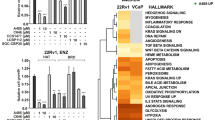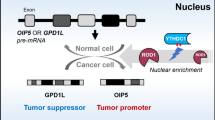Abstract
Mammalian SFMBTs have been considered to be polycomb group repressors. However, molecular mechanisms underlying mammalian SFMBTs-mediated gene regulation and their biological function have not been characterized. In the present study, we identified YY1 and methylated histones as interacting proteins of human SFMBT2. We also found that human SFMBT2 binds preferentially to methylated histone H3 and H4 that are associated with transcriptional repression. Using DU145 prostate cancer cells as a model, we showed that SFMBT2 has a transcriptional repression activity on HOXB13 gene expression. In addition, occupancy of SFMBT2 coincided with enrichment of di- and tri-methylated H3K9 and H4K20 as well as tri-methylated H3K27 at the HOXB13 gene promoter. When SFMBT2 was depleted by siRNA in DU145 prostate cancer cells, significant up-regulation of HOXB13 gene expression and decreased cell growth were observed. Collectively, our findings indicate that human SFMBT2 may regulate cell growth via epigenetic regulation of HOXB13 gene expression in DU145 prostate cancer cells.




Similar content being viewed by others
References
Begon DY, Delacroix L, Vernimmen D, Jackers P and Winkler R 2005 Yin Yang 1 cooperates with activator protein 2 to stimulate ERBB2 gene expression in mammary cancer cells. J. Biol. Chem. 280 24428–24434
Bonasio R, Lecona E and Reinberg D 2010 MBT domain proteins in development and disease. Semin. Cell Dev. Biol. 21 221–230
Cui H, Hu B, Li T, Ma J, Alam G, Gunning WT and Ding HF 2007 Bmi-1 is essential for the tumorigenicity of neuroblastoma cells. Am. J. Pathol. 170 1370–1378
Donohoe ME, Zhang X, McGinnis L, Biggers J, Li E and Shi Y 1999 Targeted disruption of mouse Yin Yang 1 transcription factor results in peri-implantation lethality. Mol. Cell. Biol. 19 7237–7244
Frankenberg S, Smith L, Greenfield A and Zernicka-Goetz M 2007 Novel gene expression patterns along the proximo-distal axis of the mouse embryo before gastrulation. BMC Dev. Biol. 7, 8
Grimm C, Matos R, Ly-Hartig N, Steuerwald U, Lindner D, Rybin V, Muller J and Muller CW 2009 Molecular recognition of histone lysine methylation by the Polycomb group repressor dSfmbt. EMBO J. 28 1965–1977
Gordon S, Akopyan G, Garban H and Bonavida B 2006 Transcription factor YY1: structure, function, and therapeutic implications in cancer biology. Oncogene 25 1125–1142
Harlow E and Lane D 1988 Using antibodies: a laboratory manual (New York: Cold Spring Harbor Laboratory Press) pp 55–137
Izzo A and Schneider R 2011 Chatting histone modifications in mammals. Brief Funct. Genomics 9 429–443
Jung C, Kim RS, Lee SJ, Wang C and Jeng MH 2004a HOXB13 homeodomain protein suppresses the growth of prostate cancer cells by the negative regulation of T-cell factor 4. Cancer Res. 64 3046–3051
Jung C, Kim RS, Zhang HJ, Lee SJ and Jeng MH 2004b HOXB13 induces growth suppression of prostate cancer cells as a repressor of hormone-activated androgen receptor signaling. Cancer Res. 64 9185–9192
Kirmizis A, Bartley SM, Kuzmichev A, Margueron R, Reinberg D, Green R and Farnham PJ 2004 Silencing of human polycomb target genes is associated with methylation of histone H3 Lys 27. Genes Dev. 18 1592–1605
Kleer CG, Cao Q, Varambally S, Shen R, Ota I, Tomlins SA, Ghosh D, Sewalt RG, Otte AP, Hayes DF, Sabel MS, Livant D, Weiss SJ, Rubin MA and Chinnaiyan AM 2003 EZH2 is a marker of aggressive breast cancer and promotes neoplastic transformation of breast epithelial cells. Proc. Natl. Acad. Sci. USA 100 11606–11611
Klymenko T, Papp B, Fischle W, Kocher T, Schelder M, Fritsch C, Wild B, Wilm M and Muller J 2006 APolycomb group protein complex with sequence-specific DNA-binding and selective methyl-lysine-binding activities. Genes Dev. 20 1110–1122
Kotake Y, Cao R, Viatour P, Sage J, Zhang Y and Xiong Y 2007 pRB family proteins are required for H3K27 trimethylation and Polycomb repression complexes binding to and silencing p16INK4alpha tumor suppressor gene. Genes Dev. 21 49–54
Kuzmin A, Han Z, Golding MC, Mann MR, Latham KE and Varmuza S 2008 The PcG gene Sfmbt2 is paternally expressed in extraembryonic tissues. Gene Expr. Patterns 8 107–116
Lee JK, Lee DH, Sun EG, Bae JA, Lim SC, Min JJ, Sung MW and Kim KK 2011 Gene therapy for head and neck squamous cell carcinoma using KITENIN (KAI1 COOH-Terminal Interacting Tetraspanin)-antisense therapy. Yonsei Med. J. 52 463–468
Lukacs RU, Memarzadeh S, Wu H and Witte ON 2010 Bmi-1 is a crucial regulator of prostate stem cell self-renewal and malignant transformation. Cell Stem Cell 7 682–693
Maurer-Stroh S, Dickens NJ, Hughes-Davies L, Kouzarides T, Eisenhaber F and Ponting CP 2003 The Tudor domain 'Royal Family': Tudor, plant Agenet, Chromo, PWWP and MBT domains. Trends Biochem. Sci. 28 69–74
Morey L and Helin K 2010 Polycomb group protein-mediated repression of transcription. Trends Biochem. Sci. 35 323–332
Raffo A, Lai JC, Stein CA, Miller P, Scaringe S, Khvorova A, and Benimetskaya L 2004 Antisense RNA down-regulation of bcl-2 expression in DU145 prostate cancer cells does not diminish the cytostatic effects of G3139 (Oblimersen). Clin. Cancer Res. 10 3195–3206
Ren G, Zhang G, Dong Z, Liu Z, Li L, Feng Y, Su D, Zhang Y, Huang B and Lu J 2009 Recruitment of HDAC4 by transcription factor YY1 represses HOXB13 to affect cell growth in AR-negative prostate cancers. Int. J. Biochem. Cell Biol. 41 1094–1101
Rosenfeld JA, Wang Z, Schones DE, Zhao K, DeSalle R and Zhang MQ 2009 Determination of enriched histone modifications in non-genic portions of the human genome. BMC Genomics 10 143
Seligson D, Horvath S, Huerta-Yepez S, Hanna S, Garban H, Roberts A, Shi T, Liu X, Chia D, Goodglick L and Bonavida B 2005 Expression of transcription factor Yin Yang 1 in prostate cancer. Int. J. Oncol. 27 131–141
Sui G, Affar el B, Shi Y, Brignone C, Wall NR, Yin P, Donohoe M, Luke MP, Calvo D and Grossman SR 2004 Yin Yang 1 is a negative regulator of p53. Cell 117 859–872
Varambally S, Dhanasekaran SM, Zhou M, Barrette TR, Kumar-Sinha C, Sanda MG, Ghosh D, Pienta KJ, Sewalt RG, Otte AP, Rubin MA and Chinnaiyan AM 2002 The polycomb group protein EZH2 is involved in progression of prostate cancer. Nature 419 624–629
Wang H, Wang L, Erdjument-Bromage H, Vidal M, Tempst P, Jones RS and Zhang Y 2004 Role of histone H2A ubiquitination in Polycomb silencing. Nature 431 873–878
Wu S, Trievel RC and Rice JC 2007 Human SFMBT is a transcriptional repressor protein that selectively binds the N-terminal tail of histone H3. FEBS Lett. 581 3289–3296
Acknowledgements
No author on this manuscript reported any conflict of interest. This work was supported by Basic Science Research Program (20110003578) and National Nuclear R&DProgram (20100017607) through the National Research Foundation of Korea (NSF) funded by the Ministry of Education, Science and Technology, the Republic of Korea.
Author information
Authors and Affiliations
Corresponding author
Additional information
Corresponding editor: Indranil Dasgupta
MS received 02 August 2012; accepted 14 November 2012
Corresponding editor: Indranil Dasgupta
[Lee K, Na W , Maeng J-H, Wu H and Ju B-G 2013 Regulation of DU145 prostate cancer cell growth by Scm-like with four mbt domains 2. J. Biosci. 38 1–8] DOI 10.1007/s12038-012-9283-6
Kwanghyun Lee and Wonho Na contributed equally to this work.
Rights and permissions
About this article
Cite this article
Lee, K., Na, W., Maeng, JH. et al. Regulation of DU145 prostate cancer cell growth by Scm-like with four mbt domains 2. J Biosci 38, 105–112 (2013). https://doi.org/10.1007/s12038-012-9283-6
Received:
Accepted:
Published:
Issue Date:
DOI: https://doi.org/10.1007/s12038-012-9283-6




